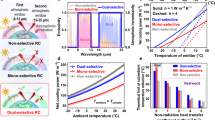Abstract
The spectral selective absorbing film is suitable for the renovation of windows and curtain walls of existing buildings to improve building energy efficiency due to special optical and thermal properties. The thermal and energy performance of the spectral selective absorbing film strongly depends on the environmental conditions, but the present performance study is mostly focused on moderate or warm climate conditions. In this paper, the thermal and energy performances of the spectral selective absorbing film in a cold climate region were investigated by the temperature test chambers installing spectral selective absorbing film glass and normal glass, exposed outdoor to acquire the air temperature and calculate the energy consumption. The results show that the spectral selective absorbing film can not only not increase the heating energy load in winter, but also significantly reduce the cooling energy load in summer. Furthermore, it can be predicted that the annual energy loads can be reduced when using the spectral selective absorbing film in a cold climate region. In addition, the heating energy-saving performance of spectral selective absorbing films in the residential building is more effective than in the office building.







Similar content being viewed by others
References
Ali H et al (2017) Key design features of multi-vacuum glazing for windows a review. Therm Sci 21(6B):2673–2687
Choi K et al (2013) Ag nanowire-embedded ITO films as a near-infrared transparent and flexible anode for flexible organic solar cells. Sol Energy Mater Sol Cells 110:147–153
Cristina C et al (2015) A new method for the thermal characterization of transparent and semi-transparent materials using outdoor measurements and dynamic simulation. Energy & Buildings 104:57–64
Elisa M, Elisa B (2015) Evaluation of energy, thermal, and daylighting performance of solar control films for a case study in moderate climate. Build Environ 94:183–195
Erdem C et al (2014) Performance investigation of heat insulation solar glass for low-carbon buildings. Energy Convers Manag 88:834–841
Estrada-Gasca et al (1993) Thermal performance of an architectural window with chemically deposited SnS-CuxS solar control coating. Renew Energy 3(6):683–690
Fei Z et al (2018) Preparation and characterization of glass fiber/polyimide/SiO2 composite aerogels with high specific surface area. J Mater Sci 53(18):12885–12893
Flores JJ et al (2008) Thermal performance of a cubic cavity with a solar control coating deposited to a vertical semitransparent wall. Sol Energy 82(7):588–601
Gijón-Rivera et al (2011) Appraisal of thermal performance of a glazed office with a solar control coating: cases in Mexico and Canada. Build Environ 46(5):1223–1233
Hamberg I, Granqvist CG (1986) Evaporated Sn-doped In2O3 films, basic optical properties and applications to energy-efficient windows. J Appl Phys 60(11):123–159
J X et al (2014) Thermal analysis for a double pane window with a solar control film for using in cold and warm climates. Energy & Buildings 76:429–439
Jesus C, Rafael A (2006) Solar filters based on iron oxides used as efficient windows for energy savings. Sol Energy 81(1):13–19
Li DHW et al (2004) Lighting and energy performance of solar film coating in air-conditioned cellular offices. Renew Energy 29(6):921–937
Li C, Tan J, Chow TT, Qiu Z (2015) Experimental and theoretical study on the effect of window films on building energy consumption. Energy and Buildings 102:129–138
Li D et al (2020) Scalable and hierarchically designed polymer film as a selective thermal emitter for high-performance all-day radiative cooling. Nat Nanotechnol 11:1–6
Noh-Pat F et al (2011) Thermal analysis for a double glazing unit with and without a solar control film (SnS-CuxS) for using in hot climates. Energy and Buildings 43(2):704–712
Teixeira H et al (2020) Thermal and visual comfort, energy use and environmental performance of glazing systems with solar control films. Build Environ 168(1-14):106474
Umberto B (2019) Light transmittance characterization and energy-saving analysis of a new selective coating for in situ window retrofit. Science and Technology for the Built Environment 25(9):1–12
Wamae W et al (2018) Influence of tin content on spectral selectivity and thermal conductivity of Sn-Al2O3 solar selective absorber. Materials For Renewable and Sustainable Energy 7(1):2–8
Wang L et al (2019) Computational fluid-dynamics-based simulation of heat transfer through vacuum glass. European Physical Journal Plus 134(7):351
Wu B et al (2011) Study progress of nano-heat-insulating glass coatings. Electroplating & Finishing 30(12):67–72
Xamán J et al (2009) Conjugate turbulent heat transfer in a square cavity with a solar control coating deposited to a vertical semitransparent wall. Int J Heat Fluid Flow 30(2):237–248
Xu X, Zhang W, Hu Y, Wang Y, Lu L, Wang S (2017) Preparation and overall energy performance assessment of wide waveband two-component transparent NIR shielding coatings. Sol Energy Mater Sol Cells 168:119–129
Yin R et al (2011) Case study: energy savings from solar window film in two commercial buildings in Shanghai. Energy & Buildings 45:132–140
Zhang W, Lu L (2019) Overall energy assessment of semi-transparent photovoltaic insulated glass units for building integration under different climate conditions. Renew Energy 134:818–827
Author information
Authors and Affiliations
Corresponding author
Ethics declarations
Conflict of interest
The authors declare that they have no competing interests.
Additional information
Responsible Editor: Santanu Banerjee
Rights and permissions
About this article
Cite this article
Zhu, S., Chen, X. & Chen, T. Evaluation of thermal and energy performance of spectral selective absorbing film using outdoor measurements in cold climate . Arab J Geosci 14, 1672 (2021). https://doi.org/10.1007/s12517-021-08093-0
Received:
Accepted:
Published:
DOI: https://doi.org/10.1007/s12517-021-08093-0




